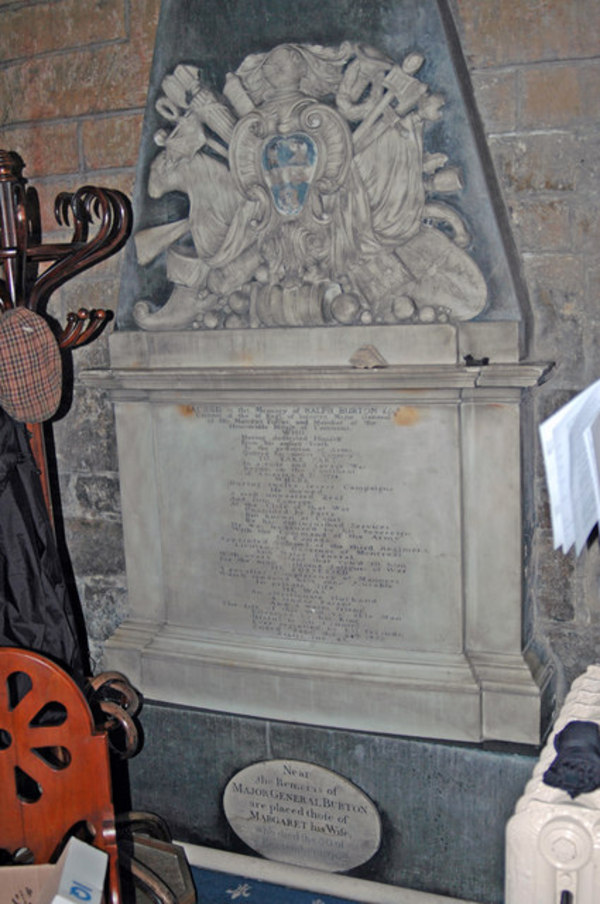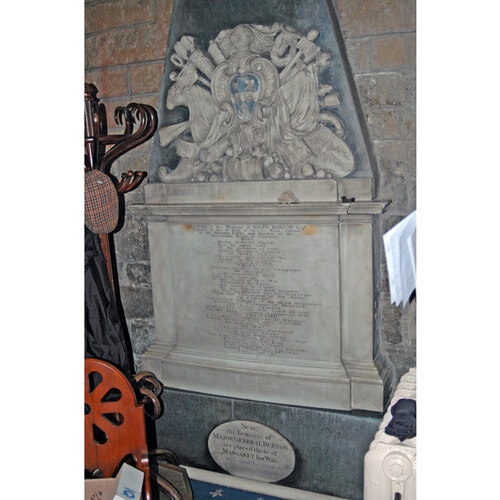
Source: Courtesy of Wikimedia Commons
BURTON, RALPH, military officer, lieutenant governor of the town of Quebec, of the Trois-Rivières district, and of the Montreal district, brigadier (commander-in-chief) of the Northern Department; d. in 1768 at Scarborough, Yorkshire, England.
Ralph Burton’s origins are obscure, even the date and place of his birth being unknown. He is said to have been the son of a Yorkshire attorney, and his will makes a cousin, Robert Burton of Hotham, Yorkshire, his executor. He first came to prominence in the Seven Years’ War in North America. In 1754 he was commissioned lieutenant-colonel in the 48th regiment and, serving under General Edward Braddock, was wounded in the expedition defeated on the Monongahela on 9 July 1755. In 1756–57 he served under Lord Loudoun [John Campbell] who commended him as “a diligent, sensible man.” Burton commanded the 3rd brigade at Louisbourg, Île Royale (Cape Breton Island), in 1758, and in July 1759 he escorted Wolfe when he reconnoitred before Quebec. He was wounded at the end of July in the attack at Montmorency Falls, presumably not seriously for he commanded a reserve of the 48th on the Plains of Abraham and received Wolfe’s dying command to cut off the retreating French at the Rivière Saint-Charles.
Burton spent the winter of 1759–60 as lieutenant governor, under James Murray*, military governor, at Quebec. On 28 April 1760 Murray led his forces to meet the French under Lévis* at Sainte-Foy, Burton commanding his right wing. During the battle the right wing retreated in disorder and Murray’s force narrowly escaped disastrous defeat. At the time Murray did not hold Burton responsible; nor did two other officers, Captain John Knox* and Major Patrick Mackellar*, who left accounts of the battle. Later, after Murray and Burton had quarrelled, Murray stated that Burton had been to blame, and that he had mistakenly saved his junior from a court martial.
Shortly after the battle of Sainte-Foy British reinforcements arrived and Burton proceeded with Murray upriver to meet Jeffery Amherst* at Montreal where, on 8 Sept. 1760, the French army under Governor General Pierre de Rigaud* de Vaudreuil capitulated, surrendering the entire colony and the upper posts. Amherst, as commander-in-chief, made arrangements for the military administration of the colony before returning to New York. He retained the French administrative districts of Quebec, Trois-Rivières, and Montreal, appointed Thomas Gage* lieutenant governor of Montreal and Burton in the same capacity at Trois-Rivières, and confirmed Murray’s governorship of Quebec. All three from both prudence and principle followed a conciliatory policy towards the Canadians, a policy approved by Amherst and practised by Murray during the previous winter in Quebec. The pledge of freedom of worship was scrupulously maintained, services from the habitants, though commandeered, were paid for, and efforts were made to check speculation in scarce food supplies and to send wheat from the upper districts to the town of Quebec, still suffering from the 1759 campaign. Justice was administered by military courts, with the help of the Canadian captains of militia, and according to local custom.
In 1762 Burton left Trois-Rivières for ten months’ service in the West Indies. A few months after his return in 1763, Gage was sent to New York as acting commander-in-chief when Amherst went on leave, and Burton was transferred to Montreal from Trois-Rivières, being succeeded by Frederick Haldimand*.
According to Murray, Burton and Gage both hoped to be appointed civil governor of the new province of Quebec inaugurated in August 1764 and were resentful when Murray was chosen. Burton was offered instead the civilian post of lieutenant governor of Trois-Rivières. He refused, and requested to be allowed to go home to look after his private affairs and his health. It appears from Murray’s letters, however, that Burton was rather gloomily contemplating retirement on half pay in England and that he was happy to be saved from this fate by new arrangements following Amherst’s decision in 1764 not to return to North America. Gage remained at New York as commander-in-chief of the forces in America, and in October 1764 Burton learned from Gage that he was to be commissioned brigadier (commander-in-chief) of the Northern Department with headquarters at Montreal. Under Gage, he now commanded all troops in the newly defined province of Quebec and in the upper posts. He was therefore senior in military rank to Murray, under whom he had served in the Quebec campaign, and who was now, as civil governor, without a military command.
This awkward arrangement was most displeasing to Murray, who had assumed that he would also command the troops within the province. Murray argued that the tradition of New France where the governor had been commander-in-chief should have been followed. Not only did Murray’s judgement condemn in the special circumstances of Quebec the usual American arrangement of separate military and civilian commands, but his vanity was deeply hurt and his warm friendship for Burton turned to suspicion and bitter dislike.
Burton’s position in Montreal was a difficult one. As brigadier for the Northern Department he was charged with the defence of the whole province, and particularly of Michilimackinac, Detroit, and other posts on the Great Lakes. Their commandants were ultimately responsible for the good conduct of fur-traders, for relations with the Indians, and, in general, for the security from the interior of the colony. While military rule lasted Burton could commandeer men, carts, and canoes for the transport of essential supplies to these up-country stations. Under civil government the practice was of doubtful legality and Murray, as governor, decided that it should be exercised only on his authority and through the justices of the peace.
The justices, however, constituted another of Burton’s problems. Canadians as Roman Catholics being deemed ineligible, those appointed were retired officers or members of the small group of English merchants. These merchants had disliked the rule of military officers who, concerned to maintain good relations with the Canadians, had occasionally been careless of the rights and sensibilities of their fellow countrymen. One particular cause of resentment was the billeting of troops in Montreal. Until August 1764 billets had been found by the captains of militia, and any householder could be required to receive soldiers. Henceforth those merchants who were justices of the peace had to find the billets, but were themselves exempt from the never very welcome guests.
Thus in these two operations of government Burton had henceforth to secure the authority of Murray, and work through civilians who traditionally resented military authority and who might remember previous slights and hardships. Both the provision for transport duty and the finding of billets led to complex legal and jurisdictional disputes between Burton and Murray, disputes inflamed by their personal quarrel. Murray accused Burton of meddling in civil matters and of irritating the merchants; Burton retorted that Murray refused him the cooperation due to the commander of the troops in the performance of essential military duties.
It is difficult to judge this quarrel fairly as the chief source of information is Murray’s letters to his superiors and friends. The few letters of Burton that survive are not revealing and any reconstruction of his character and conduct at this time must be largely based on speculation. In January 1765 the Earl of Halifax as secretary of state wrote to Burton ordering him not to meddle in civil affairs. In the colony, with its vociferous English and American merchants, the closest cooperation between governor and commander-in-chief was essential: there is no doubt that this was lacking. By 1766 Burton and Murray were barely on speaking terms and relations between the army and merchants so bad as to constitute a serious threat of disorder. In 1766 both men were recalled to Britain. This was the end of Burton’s active career. He died at Scarborough in 1768. His will, dated 7 Feb. 1767, mentions a wife, Margaret, and a son and daughter; he appears to have been a good deal older than his wife. At this time he owned an estate in the parish of Cottingham, Yorkshire, and a house in London.
Burton seems to have won the confidence of officers under whom he served, with the possible exception of Murray at Sainte-Foy, but ten years of active service probably unfitted him for the difficult problems that he encountered in Quebec at the conclusion of the peace.
PAC, MG 23, GII, 1; RG 1, E1, 1–6; RG 4, A1, 2–16. PRO, CO 5; 42/1–42/26; Prob., 11/948, f.512. Knox, Historical journal (Doughty). Frégault, La guerre de la conquête, 138–40. Neatby, Quebec. R. M. Pargellis, Lord Loudoun in North America (New Haven, Conn., London, 1933).
Cite This Article
Hilda Neatby, “BURTON, RALPH,” in Dictionary of Canadian Biography, vol. 3, University of Toronto/Université Laval, 2003–, accessed April 4, 2025, https://www.biographi.ca/en/bio/burton_ralph_3E.html.
The citation above shows the format for footnotes and endnotes according to the Chicago manual of style (16th edition). Information to be used in other citation formats:
| Permalink: | https://www.biographi.ca/en/bio/burton_ralph_3E.html |
| Author of Article: | Hilda Neatby |
| Title of Article: | BURTON, RALPH |
| Publication Name: | Dictionary of Canadian Biography, vol. 3 |
| Publisher: | University of Toronto/Université Laval |
| Year of revision: | 1974 |
| Access Date: | April 4, 2025 |



